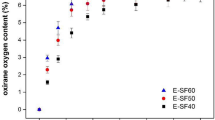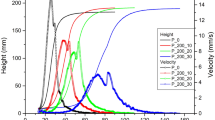Abstract
In this article, the degradability by Aspergillus niger and Aspergillus clavatus of three bio-based polyurethane (PU) foams is compared to previous degradability studies involving a Pseudomonas sp. bacterium and similar initial materials (Spontón et al. in Int. Biodet. Biodeg. 85:85–94, 2013, https://doi.org/10.1016/j.ibiod.2013.05.019). First, three new polyester-polyurethane foams were prepared from mixtures of castor oil (CO), maleated castor oil (MACO), toluene diisocyanate (TDI), and water. Then, their degradation tests were carried out in an aqueous medium, and employing the two mentioned fungi, after their isolation from the environment. From the degradation tests, the following was observed: (a) the insoluble (and slightly collapsed) foams exhibited free hydroxyl, carboxyl, and amine moieties; and (b) the water soluble (and low molar mass) compounds contained amines, carboxylic acids, and glycerol. The most degraded foam contained the highest amount of MACO, and therefore the highest concentration of hydrolytic bonds. A basic biodegradation mechanism was proposed that involves hydrolysis and oxidation reactions.
Graphical abstract









Similar content being viewed by others
References
Amaral JS, Sepúlveda M, Cateto CA, Fernandes IP, Rodrigues AE, Belgacem MN, Barreiro MF (2012) Fungal degradation of lignin-based rigid polyurethane foams. Polym Degrad Stab 97(10):2069–2076. https://doi.org/10.1016/j.polymdegradstab.2012.03.037
ASTM International D4274-16. West Conshohocken, United States
ASTM International D5338-15. West Conshohocken, United States
ASTM International D-6691-17. West Conshohocken, United States
Barratt SR, Ennos AR, Greenhalgh M, Robson GD, Handley PS (2003) Fungi are the predominant micro-organisms responsible for degradation of soil-buried polyester polyurethane over a range of soil water holding capacities. J Appl Microbiol 95(1):78–85. https://doi.org/10.1046/j.1365-2672.2003.01961.x
Bote SD, Kiziltas A, Scheper I, Mielewski D, Narayan R (2021) Biobased flexible polyurethane foams manufactured from lactide-based polyester-ether polyols for automotive applications. J Appl Polym Sci 138(29):50690. https://doi.org/10.1002/app.50690
Chojnacka K, Skrzypczak D, Mikula K, Witek-Krowiak A, Izydorczyk G, Kuligowski K, Kuligowski K, Bandrów P, Kułażyński M (2021) Progress in sustainable technologies of leather wastes valorization as solutions for the circular economy. J Clean Prod 313:127902. https://doi.org/10.1016/j.jclepro.2021.127902
Christenson EM, Anderson JM, Hiltner A (2004) Oxidative mechanisms of poly(carbonate urethane) and poly(ether urethane) biodegradation: in vivo and in vitro correlations. J Biomed Mater Res A 70(2):245–255. https://doi.org/10.1002/jbm.a.30067
Cosgrove L, McGeechan PL, Robson GD, Handley PS (2007) Fungal communities associated with degradation of polyester polyurethane in soil. App Environ Microb 73(18):5817–5824. https://doi.org/10.1128/AEM.01083-07
Cregut M, Bedas M, Durand MJ, Thouand G (2013a) New insights into polyurethane biodegradation and realistic prospects for the development of a sustainable waste recycling process. Biotechnol Adv 31(8):1634–1647. https://doi.org/10.1016/j.biotechadv.2013.08.011
Das S, Pandey P, Mohanty S, Nayak SK (2017) Evaluation of biodegradability of green polyurethane/nanosilica composite synthesized from transesterified castor oil and palm oil based isocyanate. Int Biodeterior Biodegradation 117:278–288. https://doi.org/10.1016/j.ibiod.2017.01.015
European Bioplastics, Nova-Institute (2020) Bioplastics market data. http://www.european-bioplastics.org/market/. Accessed 10 Aug 2021
Fernandez IP, Barbosa M, Amaral JS, Pinto V, Rodrigues JL, Ferreira MJ, Barreiro MF (2016) Biobased additives as biodegradability enhancers with application in TPU-based footwear components. J Renew Mater 4(1):47–56. https://doi.org/10.7569/JRM.2015.634126
Gama NV, Ferreira A, Barros-Timmons A (2018) Polyurethane foams: past, present, and future. Materials 11(10):1841. https://doi.org/10.3390/ma11101841
Gómez-Rojo R, Alameda L, Rodríguez Á, Calderón V, Gutiérrez-González S (2019) Characterization of polyurethane foam waste for reuse in eco-efficient building materials. Polymers 11(2):359. https://doi.org/10.3390/polym11020359
Gunawan NR, Tessman M, Schreiman AC, Simkovsky R, Samoylov AA, Neelakantan NK, Bemis TA, Burkart MD, Pomeroy RS, Mayfield SP (2020) Rapid biodegradation of renewable polyurethane foams with identification of associated microorganisms and decomposition products. Bioresour Technol Rep 11:100513. https://doi.org/10.1016/j.biteb.2020.100513
John G, Nagarajan S, Vemula PK, Silverman JR, Pillai CKS (2019) Natural monomers: a mine for functional and sustainable materials—occurrence, chemical modification and polymerization. Prog Polym Sci 92:158–209. https://doi.org/10.1016/j.progpolymsci.2019.02.008
Kairytė A, Vaitkus S, Kremensas A, Pundienė I, Członka S, Strzelec K (2019) Moisture-mechanical performance improvement of thermal insulating polyurethane using paper production waste particles grafted with different coupling agents. Constr Build Mater 208:525–534. https://doi.org/10.1016/j.conbuildmat.2019.03.048
Khan S, Nadir S, Shah ZU, Shah AA, Karunarathna SC, Xu J, Khan A, Munir S, Hasan F (2017) Biodegradation of polyester polyurethane by Aspergillus tubingensis. Environ Pollut 225:469–480. https://doi.org/10.1016/j.envpol.2017.03.012
Magnin A, Hoornaert L, Pollet E, Laurichesse S, Phalip V, Avérous L (2019) Isolation and characterization of different promising fungi for biological waste management of polyurethanes. Microb Biotechnol 12(3):544–555. https://doi.org/10.1111/1751-7915.13346
Magnin A, Pollet E, Phalip V, Avérous L (2020) Evaluation of biological degradation of polyurethanes. Biotechnol Adv 39:107457. https://doi.org/10.1016/j.biotechadv.2019.107457
Mahajan N, Gupta P (2015) New insights into the microbial degradation of polyurethanes. RSC Adv 5(52):41839–41854. https://doi.org/10.1039/C5RA04589D
Mathur G, Prasad R (2012) Degradation of polyurethane by Aspergillus flavus (ITCC 6051) isolated from soil. Appl Biochem Biotechnol 167(6):1595–1602. https://doi.org/10.1007/s12010-012-9572-4
Mazo P, Estenoz D, Sponton M, Rios L (2012) Kinetics of the transesterification of castor oil with maleic anhydride using conventional and microwave heating. J Am Oil Chem Soc 89(7):1355–1361. https://doi.org/10.1007/s11746-012-2020-3
Nadeau LJ, Barlow DE, Hung CS, Biffinger JC, Crouch AL, Hollomon JM, Ecker CD, Russell JN Jr, Crookes-Goodson WJ (2021) Colonization and degradation of polyurethane coatings by Pseudomonas protegens biofilms is promoted by PueA and PueB hydrolases. Int Biodeterior Biodegradation 156:105121. https://doi.org/10.1016/j.ibiod.2020.105121
Oprea S, Gradinariu P, Oprea V (2019) Properties and fungal biodegradation of the different cellulose derivatives structure included into castor oil-based polyurethane composites. J Comp Mater 53(25):3535–3548. https://doi.org/10.1177/0021998319843334
Osman M, Satti SM, Luqman A, Hasan F, Shah Z, Shah AA (2018) Degradation of polyester polyurethane by Aspergillus sp. strain S45 isolated from soil. J Polym Environ 26(1):301–310. https://doi.org/10.1007/s10924-017-0954-0
Paraskar PM, Prabhudesai MS, Hatkar VM, Kulkarni RD (2021) Vegetable oil based polyurethane coatings—a sustainable approach: a review. Prog Org Coat 156:106267. https://doi.org/10.1016/j.porgcoat.2021
Pérez-Lara LF, Vargas-Suárez M, López-Castillo NN, Cruz-Gómez MJ, Loza-Tavera H (2016) Preliminary study on the biodegradation of adipate/phthalate polyester polyurethanes of commercial-type by Alicycliphilus sp. BQ 8. J Appl Polym Sci. https://doi.org/10.1002/app.42992
Peyrton J, Avérous L (2021) Structure-properties relationships of cellular materials from biobased polyurethane foams. Mater Sci Eng R Rep 145:100608. https://doi.org/10.1016/j.mser.2021.100608
Pitt JI, Hocking AD (2009) Fungi and food spoilage. Springer, New York. https://www.plasticseurope.org/en/resources/market-data. Accessed 10 Aug 2021
PlasticsEurope (2020) Association of plastic manufacturers in Europe and the European Association of Plastics Recycling and Recovery Organizations. Plastics—the facts 2019—an analysis of European plastics production, demand and waste data
Russell JR, Huang J, Anand P, Kucera K, Sandoval AG, Dantzler KW, Hickman D, Jee J, Kimovec FM, Koppstein D, Marks DH, Mittermiller PA, Núñez SJ, Santiago M, Townes MA, Vishnevetsky M, Williams NE, Núñez Vargas MP, Boulanger L, Bascom-Slack C, Strobel SA (2011) Biodegradation of polyester polyurethane by endophytic fungi. App Environ Microbiol 77(17):6076–6084. https://doi.org/10.1128/AEM.00521-11
Sánchez C (2020) Fungal potential for the degradation of petroleum-based polymers: an overview of macro- and microplastics biodegradation. Biotechnol Adv 40:107501. https://doi.org/10.1016/j.biotechadv.2019.107501
Shah Z, Gulzar M, Hasan F, Shah AA (2016) Degradation of polyester polyurethane by an indigenously developed consortium of Pseudomonas and Bacillus species isolated from soil. Polym Degrad Stab 134:349–356. https://doi.org/10.1016/j.polymdegradstab.2016.11.003
Shaik AH, Banerjee S, Rahaman A, Agashe S, Khan A, Chandan MR (2021) One-step synthesis and characteristics of LiOH-castor oil based stable polyurethane foam. J Polym Res 28(6):1–9. https://doi.org/10.1007/s10965-021-02580-4
Singh I, Samal SK, Mohanty S, Nayak SK (2020) Recent advancement in plant oil derived polyol-based polyurethane foam for future perspective: a review. Eur J Lipid Sci Technol 122(3):1900225. https://doi.org/10.1002/ejlt.201900225
Spontón M, Casis N, Mazo P, Raud B, Simonetta A, Ríos L, Estenoz D (2013) Biodegradation study by Pseudomonas sp. of flexible polyurethane foams derived from castor oil. Int Biodeterior Biodegradation 85:85–94. https://doi.org/10.1016/j.ibiod.2013.05.019
Sukhendu M, Sambuddha B, Chayan B, Rajkumar G, Ankit C, Kousik P (2021) Functional interplay between plastic polymers and microbes: a comprehensive. Biodegradation. https://doi.org/10.1007/s10532-021-09954-x
Urzo MLR, Cuevas VC, Opulencia RB (2017) Screening and identification of polyester polyurethane-degrading fungi. Philipp Agric Scientist 100:S72–S80. ISSN 0031-7454
Wu F, Musa OM (2016) Vegetable oil–maleic anhydride and maleimide derivatives: syntheses and properties. In: Handbook of maleic anhydride based materials. Springer, Cham, pp 151–208. https://doi.org/10.1007/978-3-319-29454-4_3
Zafar U, Houlden A, Robson GD (2013) Fungal communities associated with the biodegradation of polyester polyurethane buried under compost at different temperatures. App Environ Microbiol 79(23):7313–7324. https://doi.org/10.1128/AEM.02536-13
Zhang C, Garrison TF, Madbouly SA, Kessler MR (2017) Recent advances in vegetable oil-based polymers and their composites. Prog Poly Sci 71:91–143. https://doi.org/10.1016/j.progpolymsci.2016.12.009
Zia KM, Akram N, Tabasum S, Noreen A, Akbar MU (2021) Bio-based polymers. In: Processing technology for bio-based polymers: advanced strategies and practical aspects. pp 1–28. https://doi.org/10.1016/B978-0-323-85772-7.00007-0
Acknowledgements
The authors would like to acknowledge the Consejo Nacional de Investigaciones Científicas y Técnicas (CONICET), the Universidad Nacional del Litoral (UNL), and the Agencia Nacional de Promoción de la Investigación, el Desarrollo Tecnológico y la Innovación (Agencia I+D+i) for the financial support.
Funding
This work was sponsored by grants obtained from CONICET (Grant No. PUE2016-007), UNL (Grant No. CAI+D2020 50620190100093LI031), and Agencia I+D+i (Grant No. PICT2018-02777).
Author information
Authors and Affiliations
Corresponding author
Ethics declarations
Competing interests
The authors declare that they have no known competing financial interests or personal relationships that could have appeared to influence the work reported in this article.
Ethical approval
Not applicable.
Consent for publication
All the authors agree to publish this article.
Additional information
Publisher's Note
Springer Nature remains neutral with regard to jurisdictional claims in published maps and institutional affiliations.
Rights and permissions
Springer Nature or its licensor (e.g. a society or other partner) holds exclusive rights to this article under a publishing agreement with the author(s) or other rightsholder(s); author self-archiving of the accepted manuscript version of this article is solely governed by the terms of such publishing agreement and applicable law.
About this article
Cite this article
Polo, M.L., Russell-White, K., Vaillard, S.E. et al. Bio-based polyester-polyurethane foams: synthesis and degradability by Aspergillus niger and Aspergillus clavatus. Biodegradation 35, 315–327 (2024). https://doi.org/10.1007/s10532-023-10059-w
Received:
Accepted:
Published:
Issue Date:
DOI: https://doi.org/10.1007/s10532-023-10059-w




